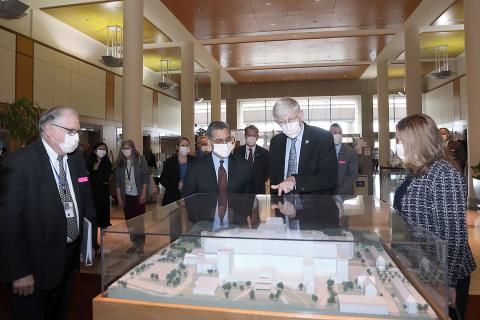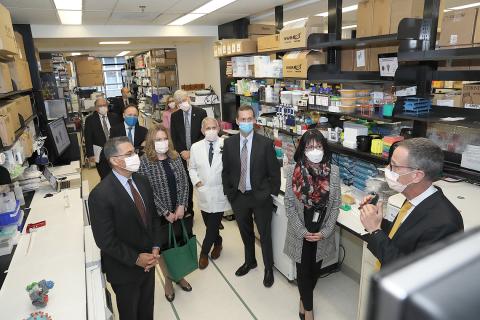HHS Secretary Becerra Visits

Photo: Chia-Chi Charlie Chang
HHS Secretary Xavier Becerra visited NIH on Nov. 4 for the first time as head of the department. Accompanied by Deputy Secretary Andrea Palm and other HHS staff, he spent more than 2 hours touring a lab in the Clinical Center, meeting with top leadership including NIH director Dr. Francis Collins, principal deputy director Dr. Lawrence Tabak and several institute and center directors, and getting briefings and a lab demonstration at the Vaccine Research Center (VRC).
“Welcome, HHS colleagues, to the NIH Clinical Research Center,” said Collins, greeting Becerra and Palm at CRC’s north entrance and describing the world’s largest hospital devoted to medical research. At the 3-D model of Bldg. 10, Collins pointed out the close relationship of hospital beds to laboratories, and gave an overview of the scientific enterprise.
“I’m fascinated to be here and to be able to see all of this,” said Becerra to Collins, in the atrium of the Clinical Research Center. “Whenever someone finds themselves or their relatives [facing a health crisis] they always say, ‘I want to be at NIH.’ And now I can see why…”
The Clinical Center is the best place to bring lawmakers, policymakers and decision-makers because it captivates them immediately and shows them why it’s important to invest in biomedical research and to commit more funding to its expansion, noted Becerra, himself a former 12-term U.S. congressman.

Photo: Chia-Chi Charlie Chang
Collins then led the small HHS delegation to a lab in NCI’s Pediatric Oncology Branch, where the group was shown around by its chief, Dr. Brigitte Widemann, and Lasker clinical scholar Dr. Jack Shern.
In the 4th floor medical board room, Becerra and Palm next met with a young man participating in an NIH clinical protocol and his mother.
Afterwards, six IC directors assembled with the secretary and deputy secretary for a briefing. Seated around the conference table, along with Collins and Tabak, were NLM director Dr. Patricia Flatley Brennan, NIAID director Dr. Anthony Fauci, NHLBI director Dr. Gary Gibbons, NIMHD director Dr. Eliseo Pérez-Stable, NCI director Dr. Ned Sharpless and NIDA director Dr. Nora Volkow.
The Dale and Betty Bumpers VRC (Bldg. 40) was the final stop on the tour, with Fauci presenting a slideshow history of the facility and an overview of Covid-19 vaccinology to the HHS visitors, gathered in a first-floor conference room.

Photo: Chia-Chi Charlie Chang
Joining HHS leaders around the table were VRC director Dr. John Mascola; VRC deputy director Dr. Richard Koup; Dr. Nancy Sullivan, chief of the biodefense research section in the VRC’s Viral Pathogenesis Laboratory; Dr. Robert Seder, chief of the cellular immunology section in NIAID’s Immunology Laboratory; and Dr. Jennifer Anderson, VRC associate director for management and operations.
Fauci described the development of a stabilized version of the spike protein on the coronavirus—SARS-CoV-2—that causes Covid-19. “This protein, which was established right here in this building, now is in 5 out of the 6 [Covid-19] vaccines that are being utilized throughout most of the world,” said Fauci, explaining how the VRC’s cadre of talented researchers and unique scientific environment contribute to the success of its mission. “So, we are really talking about how you can have fundamental basic science that emanates from a couple of investigators who collaborate with people throughout the country…you [develop] a life-saving vaccine. That to me is really an enormously important story.”

Photo: Chia-Chi Charlie Chang
His point was reiterated later in an upstairs lab by Sullivan, whose career at the VRC began in 1999, before construction of Bldg. 40. Recalling the many years of foundational research at Bldg. 40 that led to the establishment of vaccine platform prototypes, she explained how this enabled the development of Ebola vaccines and treatments.
“This is a cycle that allows us to accelerate the pace with which we discover these vaccines and respond very quickly,” Sullivan explained, “and what makes that happen is the VRC organization—the fact that we all work so closely together here lets us do this.”
Concluding the visit, Fauci pointed out that he was going to close with one of Collins’s favorite themes:
“The fact is, Mr. Secretary, that the fundamental basic research that comes out of NIH and that the HHS funds really has its fingerprints on everything that goes on everywhere [around the world] with a biomedical science basis.”
“Absolutely,” Collins confirmed, smiling, “all of it is part of our ecosystem, along with all of our sister agencies in the HHS.”
